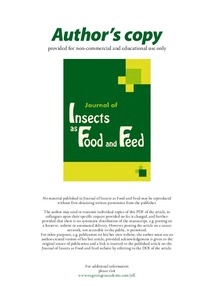| dc.contributor.author | Gatheru, J.W. |
| dc.contributor.author | Khamis, F.M. |
| dc.contributor.author | Ombura, F.L.O. |
| dc.contributor.author | Nonoh, J. |
| dc.contributor.author | Tanga, C.M. |
| dc.contributor.author | Maina, J. |
| dc.contributor.author | Mohamed, S.A. |
| dc.contributor.author | Subramanian, S. |
| dc.contributor.author | Ekesi, S. |
| dc.contributor.author | Fiaboe, K.K.M. |
| dc.date.accessioned | 2019-12-04T11:36:09Z |
| dc.date.available | 2019-12-04T11:36:09Z |
| dc.date.issued | 2019 |
| dc.identifier.citation | Gatheru, J.W., Khamis, F.M., Ombura, F.L.O., Nonoh, J., Tanga, C.M., Maina, J., ... & Fiaboe, K.K.M. (2019). Impact of processing methods on microbial load of reared and wild-caught edible crickets (Scapsipedus icipe and Gryllus bimaculatus) in Kenya. Journal of Insects as Food and Feed, 5(3), 171-183. |
| dc.identifier.issn | 2352-4588 |
| dc.identifier.uri | https://hdl.handle.net/20.500.12478/6126 |
| dc.description | Published online: 27 May 2019 |
| dc.description.abstract | The microbial composition of farmed and wild Scapsipedus icipe and Gryllus bimaculatus is presented. The aim of this study is to determine the microbial load of the two cricket species and evaluate the efficiency of processing methods (boiling, sun-drying, freeze-drying, snap-freezing and deep-frying) in reducing microbial counts. Farmed and wild species were compared based on microbial diversity. Fresh crickets had high microbial counts, bacterial and fungal populations ranged from 4.26-4.58 log cfu/g and 3.48-4.48 log cfu/g fresh weight, respectively. Upon processing, microbial counts reduced, bacterial counts ranged from 1.00-2.08 log cfu/g dry weight (boiled) and 2.70-3.34 log cfu/g dry weight (sun-dried). Fungal counts ranged from1.85-1.95 log cfu/g dry weight (boiled) and 2.95-3.51 log cfu/g dry weight (sun-dried). Deep-frying, freeze-drying and snap-freezing emerged as the best processing methods. Although there is no alarm in consuming fresh crickets, a processing method is advisable to minimize any possible risks. |
| dc.description.sponsorship | Canadian International Development Research Centre |
| dc.description.sponsorship | Australian Centre for International Agricultural Research |
| dc.description.sponsorship | Federal Ministry for Economic Cooperation and Development, Germany |
| dc.description.sponsorship | Swedish International Development Cooperation Agency |
| dc.description.sponsorship | UKAid |
| dc.description.sponsorship | Swiss Agency for Development and Cooperation |
| dc.description.sponsorship | The Kenyan Government |
| dc.format.extent | 1-14 |
| dc.language.iso | en |
| dc.rights | Copyrighted; all rights reserved |
| dc.subject | Plate Count |
| dc.subject | Pests |
| dc.subject | Pests Of Plants |
| dc.subject | Gryllus Bimaculatus |
| dc.subject | Microbial Colony Count |
| dc.title | Impact of processing methods on microbial load of reared and wild-caught edible crickets (Scapsipedus icipe and Gryllus bimaculatus) in Kenya |
| dc.type | Journal Article |
| dc.description.version | Peer Review |
| cg.contributor.affiliation | International Centre of Insect Physiology and Ecology |
| cg.contributor.affiliation | Kenyatta University |
| cg.contributor.affiliation | Jomo Kenyatta University of Agriculture and Technology |
| cg.contributor.affiliation | International Institute of Tropical Agriculture |
| cg.coverage.region | Africa |
| cg.coverage.region | East Africa |
| cg.coverage.country | Kenya |
| cg.isijournal | ISI Journal |
| cg.authorship.types | CGIAR and developing country institute |
| cg.iitasubject | Pests Of Plants |
| cg.journal | Journal of Insects as Food and Feed |
| cg.howpublished | Formally Published |
| cg.accessibilitystatus | Limited Access |
| local.dspaceid | 106389 |
| cg.targetaudience | Scientists |
| cg.identifier.doi | https://dx.doi.org/10.3920/JIFF2018.0042 |

